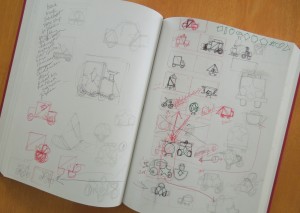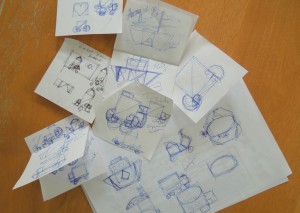 Book illustrator Chiêu Anh Urban enjoys creating fun, innovative books for the youngest readers. She designs novelty formats that provide playful exploration of early concepts. Her debut book, Raindrops: A Shower of Colors uses acetate to show how primary colors blend to make new ones. Away We Go! A Shape and Seek Book is published with Scholastic, Cartwheel this summer, and incorporates layered die-cuts to introduce shapes and transportation modes for a fun search-and-find game. When she’s not working on book ideas, she’s most likely baking and doing crafts with her girls. Visit her at http://chieuurban.blogspot.com/
Book illustrator Chiêu Anh Urban enjoys creating fun, innovative books for the youngest readers. She designs novelty formats that provide playful exploration of early concepts. Her debut book, Raindrops: A Shower of Colors uses acetate to show how primary colors blend to make new ones. Away We Go! A Shape and Seek Book is published with Scholastic, Cartwheel this summer, and incorporates layered die-cuts to introduce shapes and transportation modes for a fun search-and-find game. When she’s not working on book ideas, she’s most likely baking and doing crafts with her girls. Visit her at http://chieuurban.blogspot.com/
Q: When did you get started illustrating for children? What did you do before?
A: I have a background in communications art and design, and a career as a graphic designer.
When my girls were in preschool, I decided to make a hands-on book to teach them about colors. Raindrops: A Shower of Colors was published in 2010 with Sterling, and was the beginning of my children’s book journey. Away We Go! A Shape and Seek Book, published this summer, is my first children’s book that I illustrated as well as authored.
 Q: Your newest book “Away We Go” which you also authored came out in May 2013. What is it about?
Q: Your newest book “Away We Go” which you also authored came out in May 2013. What is it about?
A: Away We Go! A Shape and Seek Book is a novelty board book published by Scholastic, Cartwheel. This concept book introduces shapes and modes of transportation. Triangles become sailboats and hearts become airplanes as each spread reveals a different type of vehicle, made from bright colors and geometric shapes. Die-cuts of shapes are layered throughout each page, for a fun shape-and seek-game. The challenge is to find the vehicles in the shapes and the shapes in the vehicles.
Q: What did you like best about working on this book?
A: I had a lot of fun working the shape die-cuts into the illustrations. The die-cuts are layered throughout each spread, so the highlighted transportation mode transitions into the next as each page is turned.
Q: This is a board book for wee readers. How does this genre differ from a regular picture book?
A: Board books are a child’s first book. They are printed on thick cardboard and are sturdier than picture books. Board books have less spreads with fewer words. Successful picture books are often printed in board book editions.
Q: Have you worked on other novelty books?
A: My debut novelty book, Raindrops: A Shower of Colors, was published in 2010 with Sterling. It’s a playful concept book that shows children how primary colors magically blend to create secondary ones. Die-cut raindrops with a see-through shaded acetate appear throughout; when the acetates are layered on top of each other, a new color emerges.
 Q: What do you enjoy most about creating books for the very littlest readers?
Q: What do you enjoy most about creating books for the very littlest readers?
A: It’s very heartwarming to create and share a story-time experience with little children. They are learning and exploring everyday, and I love designing books that are fun for them. I also enjoy creating crafts, projects, and gifts themed by my books to enrich their experience. Here is a diaper cake I made for Operation Shower, a non-profit organization that provides baby showers for military families. I had a lot of fun creating these Away We Go! activities and party print-ables, too.
Q: What other illustration projects have you worked on?
A: Most of my artwork has been in the specialty field of graphic design, and creating logos and print materials for companies. My illustrations have mainly been a fun way for me to spend creative time.
Q: What are you working on now? Do you have any other art projects you’d like to talk about?
A: I just wrapped up a novelty concept book with animals, alphabets, and shapes. It’s bright and colorful with bold graphics, and includes die-cuts.
Q: Can you explain your art process?
A: I have several sketchbooks that I doodle ideas in. If I think I have a really good idea, then I will start fleshing it out in spreads. If that looks promising, I will creating a dummy to include the novelty features (die-cuts, acetate, etc.) and see how it works as a book. At that point, I will drop the idea if it’s not panning out, or be really excited and begin creating art for the pages. Once I’m done, I will print out the art and create a professional dummy, submit, and hope for the best!
Many of my ideas stem from restless sleep. Instead of counting sheep, I’m thinking of new concepts.




Q: Are you a full-time artist? What is your typical day like?
A: I’m a full-time mom of three kids, and have a busy household. During the school year, I have about three hours to work in between school pick-ups. Once the kids are home from school, my work day is over. If I’m really involved with a project, I’ll start-up again in the evening, when the kids are in bed.
Q: What is your favorite medium to work in? Have you always worked in this media? If not, why did you switch?
A: I don’t have a favorite medium, and choose my art media depending on the project.
I create most of my art on the iMac, and use Adobe Illustrator and Photoshop. I also love working with traditional art, and enjoy watercolor, collage, pen and ink, and chalk pastels.
Q: Do you use models/source pictures or do you draw from your memory/imagination?
A: I wish I could draw from memory, but I always look at images and resources for inspiration.
Q: What gets you through an illustration when you’re stuck for inspiration?
A: I’ll create the best illustration I can at the time, and go back to it in a few days. Having the break and a fresh eye later really helps.
Q: What one piece of advice would you share with an illustrator wanting to get into kid lit?
A: I believe the art needs to have a unique and distinct style to stand out from the rest. I create novelty books, and like for my art and design to work cleverly together.
Q: What book do you remember from when you were young?
A: I remember Tales of the Fourth Grade Nothing, by Judy Blume. My teacher read the book to the class, and I created a full size drawing of the characters, to decorate the door of the classroom. I was really surprised from all the attention the illustration received from the students and teachers. It was a special school memory for me.
Q: Is there a children’s book illustrator whose work you gravitate towards in the bookstore now?
A: I love looking at Eric Carle’s work. His illustrations are bold in color and design, and I find them very charming.
Q: If you could illustrate any writer’s new work, who would it be?
A: Eric Carles.

 RSS - Posts
RSS - Posts